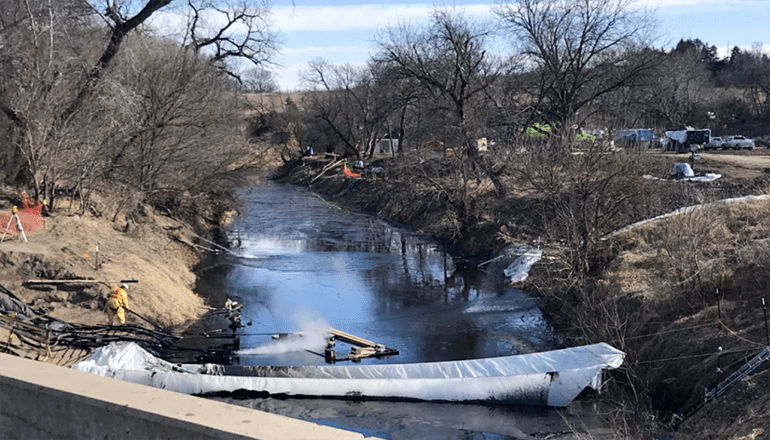(Missouri Independent) – Owners of the Keystone pipeline knew a defect had formed years before the strain finally caused the pipeline to burst and flood a Kansas creek with oil last year.
The Keystone pipeline, owned by TC Energy, burst near the Kansas-Nebraska border late last year, spilling almost 13,000 barrels of oil onto adjacent farmland and into Mill Creek.
It was the largest spill since the pipeline started operating a decade ago and larger than all the others combined. While the December spill was the most severe, it was caused by a manufacturing defect that worsened under stress, like most earlier breaches.
Bill Caram, executive director of Pipeline Safety Trust, said any failure that affects the environment is alarming.
“But the fact that we have a history of these construction issues on this pipeline and we have another failure because of that — I think it calls into question the condition of the pipeline itself,” Caram said.
Following the December spill, the federal Pipeline and Hazardous Materials Safety Administration ordered the section of the pipeline shut down and issued TC Energy a corrective action order that required the company to have the pipeline analyzed and study the root causes of the failure.
The resulting study quietly posted to the administration’s website, painted a picture of a company that overlooked warning signs and lacked appropriate safety controls. It determined a faulty weld, which was further strained by bending and a misshapen section of pipe, failed and caused the rupture.
“This root cause analysis…points to inadequate oversight in TC Energy’s policies and procedures. The fact that they had to replace this piece of the pipeline a couple of times and it still went in defective speaks a lot to that,” Caram said.
TC Energy didn’t respond directly to the findings of the study.
“As part of our commitment to learning and action, we are evaluating how we will implement the recommendations from the root cause failure analysis into our practices and standards,” TC Energy said in an unsigned statement.
According to the study, prepared by RSI Pipeline Solutions on TC Energy’s behalf, operators discovered in 2013 that the Keystone pipeline had become somewhat oval-shaped instead of round near the point where it burst 10 years later.
That and stress of the bend in the pipe strained the faulty weld. But it’s not uncommon for pipelines to become oval-shaped, so “the severity of the threat was underestimated,” the report says.
That decision not to address the ovality is one of four causal factors in the pipeline failure outlined in the report.
The report says the company failed to run an inspection tool back through the pipeline after making modifications. It also failed to properly oversee construction and quality control, which allowed for construction techniques that caused bending stress. It also followed design policies that didn’t account for the impact of stress on welds at elbows and joints.
TC Energy noted its design was “compliant with applicable codes and standards.”
“However, as part of the ongoing incorporation of our learnings … we will examine how we can further our overall safety and integrity and continue to work with industry to share these actions more broadly,” the company said.
The company has started an investigation to identify other parts of the pipeline that may have similar attributes to the section that failed. It hasn’t found any so far but anticipates the work to continue into next year, the company said.
Caram said federal regulations largely defer to pipeline operators through “performance-based” rather than “prescriptive” regulations. That’s been the case for about 20 years, and he said there hasn’t been a decline in pipeline incidents. He said a better balance between the two regulatory schemes could help.
A prescriptive regulation, Caram said, is like a speed limit. If someone drives over the speed limit, they broke the law and can get a ticket.
“A (performance-based) regulation would just be, ‘Drive safely,’ and it’s kind of up to the driver to determine what ‘drive safely’ means,’” he said. “And that makes it really hard for the regulator to hold that driver accountable.”
Caram continued: “I think the public would say, ‘Well, when you spill hundreds of thousands of gallons of crude oil into a creek, that means you weren’t operating the pipeline safely,’ but it’s not always that simple from the regulator’s point of view.”
The section of pipe that burst was a fabricated bend installed in 2010 after a previous construction defect was dug up.
In total, there are 109 similar elbow assemblies, according to the report.
(Photo courtesy EPA)


